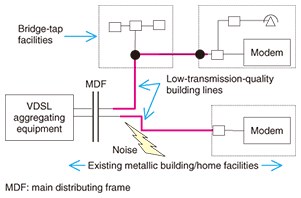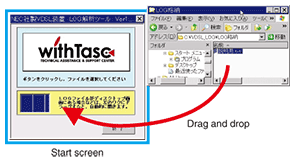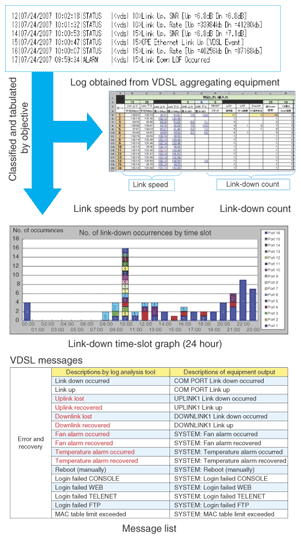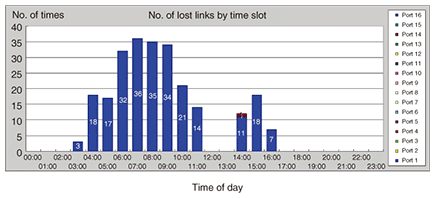 |
|||
|
|
|||
|
Special Feature on Technical Solutions to Real-world Problems Vol. 7, No. 9, pp. 4–6, Sept. 2009. https://doi.org/10.53829/ntr200909sf2 Log Analysis Tool for Very-high-speed Digital Subscriber Line (VDSL)AbstractThis article describes the development of a software tool for analyzing log data quickly and understanding current conditions easily. As B FLET’S and other high-speed Internet connection services continue to expand, the reasons for faults occurring in very-high-speed digital subscriber lines (VDSLs) installed in multi-dwelling units and other buildings are becoming numerous and varied. The analysis of VDSL-equipment logs is considered to be an effective means of investigating the causes of these faults.
1. BackgroundVery-high-speed digital subscriber lines (VDSLs), which consist of VDSL aggregating equipment, metallic facilities, and modems, are intended to provide B FLET’S and other types of high-speed Internet connection services to multi-dwelling units through the effective use of metallic facilities that already exist in the customer’s building. The number of subscribers to these services has been increasing steadily since their initial deployment, and during this time, system faults have been occurring for various reasons. For example, there are on-site phenomena that cause faults to occur on VDSLs although they have no influence on analog telephones that operate at low frequencies. This is because VDSL uses analog telephone facilities at higher frequencies (several tens of megahertz) than those used for analog telephones. This can make VDSL unstable. The main factors for VDSL faults are summarized below and illustrated in Fig. 1.
1) In the case of existing building/home lines in which core wires are not twisted, transmission loss is high compared with that of twisted cabling, while balance and cross-talk characteristics are inferior. 2) If bridge taps are present, signal reflection occurs in a certain frequency band, which makes that band unusable. 3) Noise in the same band as the VDSL (originating, for example, from other vendors’ equipment or from defective fluorescent lamps) can penetrate the VDSL, making that frequency band unusable. If only the VDSL is having problems while the analog phones continue to operate normally, a condition test from a test board or a noise check using an audible frequency will be ineffective at identifying the trouble. What is needed is a troubleshooting method applicable to VDSL. One such method is to analyze log data recorded in VDSL aggregating equipment. Such an analysis can also reveal faults other than those associated with a condition reported to be faulty, so it is possible to assemble staff and set up log measurement equipment appropriate to the scale and conditions of the VDSL in question beforehand. However, analyzing such a log is not without problems. For one thing, a log can contain up to 1000 records, and tabulating and classifying those records with ordinary spreadsheet software can take up to two hours or so. As a result, log analysis has not found widespread use on-site at the fault location. On a basis of the above background, NTT has developed a log analysis tool for VDSL. This software can perform high-speed, automatic classification and tabulation of log records either at maintenance points or onsite in the customer’s building. 2. Outline of log analysis tool for VDSLThis tool achieves simple and high-speed operation and produces easy-to-understand results. 2.1 Simple and high-speed operationAll processing from tabulation onward is performed automatically after the target log file has simply been dragged onto the start screen (Fig. 2). Once the log structure has been divided up and rearranged in memory and log data has been classified and tabulated, subsequent operations proceed quickly. Simplified operations and high-speed processing shorten the work time significantly to as much as 1/240 (0.4%) that of existing methods.
2.2 Easy-to-understand resultsSpreadsheets and graphs are displayed together to provide on-site maintenance personnel with a visual means of understanding current conditions. The main display items are listed below and shown in Fig. 3. 1) Configuration settings and communication speeds under link-up conditions 2) Ports associated with link-down occurrences and reasons for lost links 3) Number of fault occurrences by time slots (totals for each hour) 4) Reference table listing the meanings of log messages and conditions for fault occurrences
3. Application examplesHere, we describe a representative application example. A graph showing the number of link-down occurrences by time slot during a 57-day period is shown in Fig. 4. This graph shows how lost links occur for the most part at specific ports during certain time slots. This is because noise generated by the repeated on-and-off switching of fluorescent lamps feeds back into the same power-supply system as that used by VDSL. The graph helps the user to seek out correlations between fault occurrences and time slots and ports, and then, on the basis of this analysis, to come up with clues about the factors that could be behind those faults. All in all, the information provided by this graph can lead to a speedy resolution.
4. SummaryNTT has developed a log analysis tool for VDSL to enable log analysis to be performed quickly in the field and current conditions to be easily understood. This tool, which can be downloaded from the website of the Technical Assistance and Support Center at NTT EAST (ID required), is expected to contribute to a significant reduction in the time required to determine current conditions and restore problem links. |
|||











